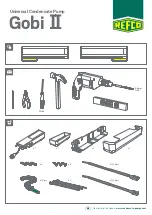
4
3P362438-1B English
3 .2 .
Technical and Electrical specifications
Refer to the Engineering Data Book for the complete list of specifica
-
tions.
3 .3 . Main components
For main components and function of the main components, refer to
the Engineering Data Book.
4 . Selecting an installation location
WARNING
Be sure to provide for adequate measures in order to prevent that the
unit is used as a shelter by small animals.
Small animals making contact with electrical parts can cause malfunc-
tions, smoke or fire. Please instruct the customer to keep the area
around the unit clean and clear.
In a domestic environment this product may cause radio interference
in which case the user may be required to take adequate measures.
CAUTION
Appliance not accessible to the general public, install it in a secured
area, protected from easy access.
This unit, both indoor and outdoor, is suitable for installation in a com-
mercial and light industrial environment.
4 .1 . General precautions on installation
Select an installation site that meets the following requirements:
•
The foundation must be strong enough to support the weight of the
unit.
• Installation location is flat to prevent vibrations and noise generation
and to have sufficient stability.
•
The space around the unit is adequate for maintenance and servic-
ing (refer to 5.2. Service space on page 6).
• The space around the unit allows for sufficient air circulation.
• There is no danger of fire due to leakage of inflammable gas.
• The equipment is not intended for use in a potentially explosive
atmosphere.
•
Select the location of the unit in such a way that the sound generat-
ed by the unit does not disturb anyone, and the location is selected
according the applicable legislation.
•
All piping lengths and distances have been taken into consideration
(refer to 7.5. System piping (length) limitations on page 11).
•
Take care that in the event of a water leak, water cannot cause any
damage to the installation space and surroundings.
•
When installing the unit in a small room, take measures in order to
keep the refrigerant concentration from exceeding allowable safety
limits in the event of a refrigerant leak, refer to 18. Caution for refrig-
erant leaks on page 43.
CAUTION
Excessive refrigerant concentrations in a closed room can lead to
oxygen deficiency.
NOTE
The equipment described in this manual may cause electronic noise
generated from radio-frequency energy. The equipment complies
to specifications that are designed to provide reasonable protection
against such interference. However, there is no guarantee that inter-
ference will not occur in a particular installation.
It is therefore recommended to install the equipment and electric wires
keeping proper distances away from stereo equipment, personal
computers, etc
3
1
4
2
5
2
A
B
B
A
A
A
B
1
Indoor unit
2
Branch switch, overcurrent breaker
3
Remote controller
4
Cool/Heat selector
5
Personal computer or radio
A
≥
60 in. (1500 mm)
B
≥
40 in. (1000 mm)
An inverter air conditioner may cause electronic noise generated from
AM broadcasting. Examine where to install the main air conditioner
and electric wires, keeping proper distances away from stereo equip-
ment, personal computers, etc.
Particularly for locations with weak reception, ensure there is a dis-
tance of at least 10 ft. (3 m) for indoor remote controllers, place power
wiring and transmission wiring in conduits, and ground the conduits.
• The refrigerant R410A itself is nontoxic, non-flammable and is safe.
If the refrigerant should leak however, its concentration may exceed
the allowable limit depending on room size. Due to this, it could be
necessary to take measures against leakage. Refer to 18. Caution
for refrigerant leaks on page 43.
•
Do not install in the following locations:
- Locations where sulfurous acids and other corrosive gases may
be present in the atmosphere. Copper piping and soldered joints
may corrode, causing refrigerant to leak.
- Locations where a mineral oil mist, spray or vapor may be pres-
ent in the atmosphere. Plastic parts may deteriorate and fall off or
cause water leakage.
- Locations where equipment that produces electromagnetic
waves is found. The electromagnetic waves may cause the con-
trol system to malfunction, preventing normal operation.
-
Locations where flammable gases may leak, where thinner,
gasoline and other volatile substances are handled, or where
carbon dust and other incendiary substances are found in the
atmosphere. Leaked gas may accumulate around the unit, caus-
ing an explosion.
•
When installing, take strong winds, hurricanes or earthquakes into
account, improper installation may result in the unit turning over.
4 .2 . Weather related precautions
•
Select a place where the rain can be avoided as much as possible.
•
Be sure that the air inlet of the unit is not positioned towards the
main wind direction. Frontal wind will disturb the operation of the
unit. If necessary, use a screen to block the wind.
• Ensure that water cannot cause any damage to the location by
adding water drains to the foundation and prevent water traps in the
construction.
•
Do not install the unit in areas where the air contains high levels of
salt such as that near the ocean.








































